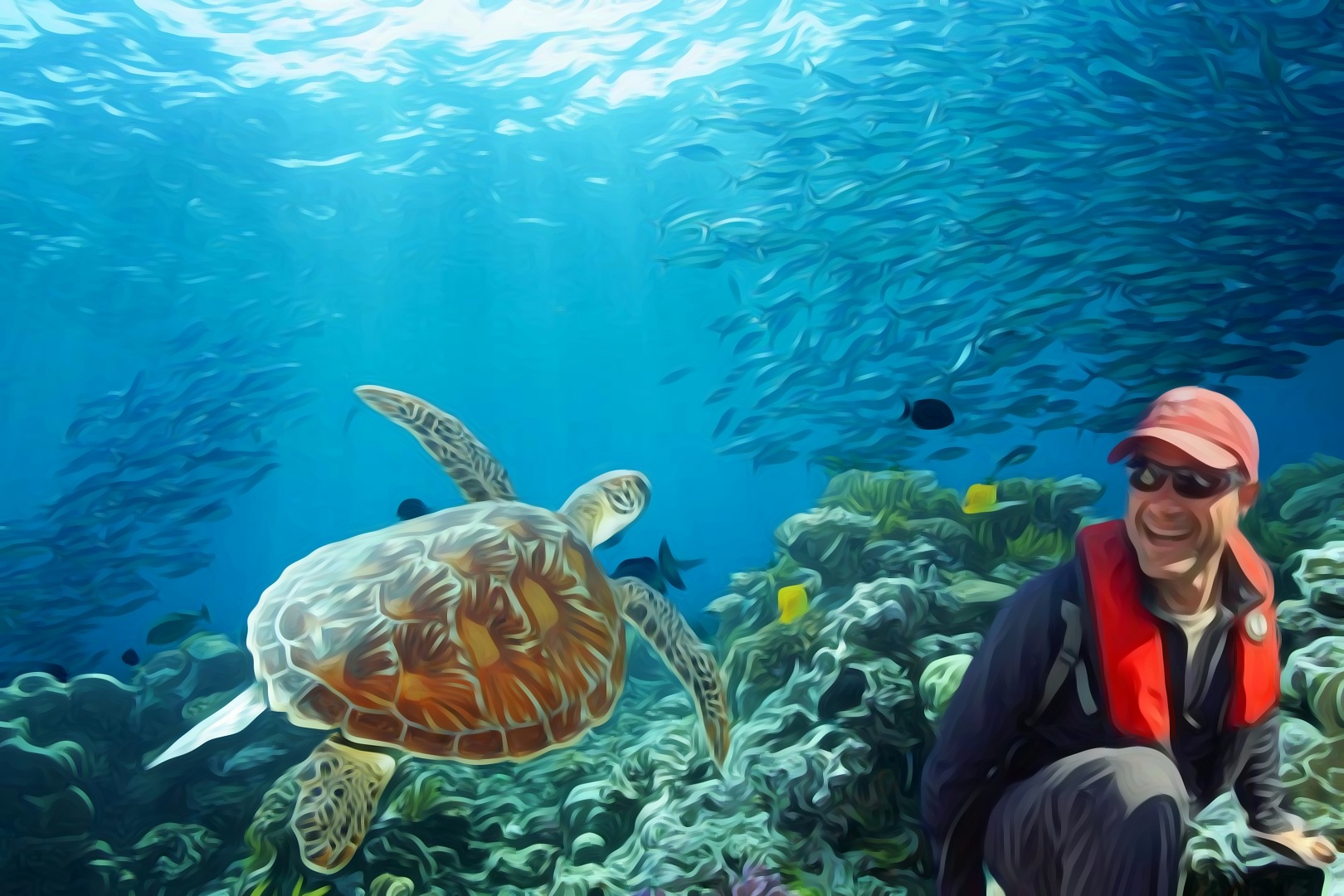Should we fear predatorial marine animals or should they fear us?
Susha Fountain and Professor Richter talk about how our actions have endangered marine life and why protecting them is crucial to preserving the entire ecosystem
Glorious, sharp-toothed, and baleen-mouthed creatures have ruled the oceans for tens of millions of years—some even before dinosaurs walked on land. Throughout the course of marine history, sharks, rays, and whales have captured humankind’s curiosity and fear. In our exploration of the oceans, we’ve studied these animals in hopes of understanding their behaviours and environments. However, we have also captured and killed them along the way. Often, this is not only a detriment to the animal but a detriment to the whole ocean ecosystem. Currently, many large fish and marine mammal species are endangered, with over 41,000 species verging on extinction. Amid controversial issues surrounding animal captivity, fisheries, and climate change, the threat of extinction these creatures face must be addressed by conservation scientists, animal caretakers, and the global community altogether.
The dangerous reputation of cetaceans (whales, dolphins, and porpoises) is a result of their role as predators in marine food webs. Susha Fountain, an educator at Ripley’s Aquarium in Downtown Toronto, teaches about shark and ray (or “elasmobranch”) conservation. In an interview with The Medium, she describes how elasmobranch’s placement as “high trophic level predators in their communities is important for maintaining ecosystem homeostasis.” She elaborates that their position at the top of the food chain is key for stability in the ecosystem despite environmental changes. When these top predators start disappearing, it disrupts the rest of the ecosystem.
University of Toronto Mississauga (UTM) professor and passionate admirer of whales, Professor Christopher Richter agrees with Fountain. When whale populations decline, Professor Richter explains, the impact can be observed in fluctuations all the way down the food web, to seagrass populations.
Professor Richter notes how “we are just starting to assess how important whales are in contributing to the idea that the oceans are a carbon sink [oceans store and absorb carbon dioxide].” Because large species, like blue whales, sequester carbon in their bodies even after they die, they play a role in combating rising atmospheric carbon levels. This carbon is further recycled into deep sea communities when whale carcasses begin to decompose—a phenomenon referred to as “whale falls.”
Having researched sperm whales during his PhD at the University of Otago, and harbour porpoises during his master’s degree at the Memorial University of Newfoundland (MUN), Professor Richter studied how their populations are impacted by human activity—the primary threat elasmobranchs and cetaceans face. Fishing, for one, presents many issues. During the first project Professor Richter worked on at MUN, he observed that “in the Bay of Fundy, little harbour porpoises get caught in ground nets for cod. […] Since they’re so close to the bottom, they asphyxiate—they can’t come back up to the surface.” This by-catch (a term for animals accidentally caught by fisheries targeting commercial species) has impacts beyond harbour porpoises.
Alongside by-catch, abandoned fishing gear poses pollution issues that can be fatal. Referred to as “ghost gear,” Professor Richter explains that buoys, nets, and lines made primarily of nylon and metal “don’t disintegrate; they’re out there for years. But [the gear] keeps fishing and nobody pulls them out, or at least not on a systematic basis.” For animals that feed on the surface, like the iconic Canadian right whale, whose population has declined to numbers lower than 350, this plastic pollution can be detrimental.
Historically, the fishing industry has caused the greatest threat to these large fish and mammal populations—the sperm whale populations that Professor Richter studied are still recovering from the hundreds of years of whale hunting, also known as whaling. However, in past decades, more complications have emerged. Fountain explains that for sharks and rays, climate change threatens to leave many species without a home. “Coral reefs only make up about 1 per cent of the ocean floor, but house around 25 per cent of marine biodiversity. […] The loss of these habitats affects the whole community but is most visible in shark and ray species because these high trophic level species need to consume the most energy,” shares Fountain. For example, Fountain points to the presence of reef sharks as a general indicator of a healthy reef because it means the ecosystem meets the high productivity levels they require.
Fountain holds a unique position as an expert in biology and marine conservation by studying and educating people on conservation and the environment while working at Ripley’s Aquarium of Canada. Conservation of marine species is as complicated as the ecological networks trying to be preserved. Professor Richter comments that “even though we might be sitting here, by Lake Ontario—really far away from the ocean—regardless, what we do has an impact on [marine organisms].”
While aquariums and zoos have a somewhat controversial reputation, they also support conservation research, advocacy, and education. The dichotomy in question is “What’s the trade-off?” Professor Richter asks, “Is it worth removing an animal from not only its habitat, but also its social environment?” Both Fountain and Professor Richter agree that most zoological societies such as Canada’s Accredited Zoos and Aquariums consider the captivity of cetaceans to be inhumane.
Professor Richter states that “Bottlenose dolphins [and] killer whales are social. And we know removing individuals from these groups has an impact on the rest.” So, although not as quantitatively detrimental to populations as fishing, captivity still raises important concerns. “Being a professor, education is always a solution or part of the solution. So, I definitely think zoos and aquariums have a role to play,” says Professor Richter. Even without displaying these species, aquariums can make a positive impact by talking about cetaceans, other species not suitable for captivity, and the threats that they endure. “The most important thing to keep in mind,” adds Fountain, “is that we are respectful to animals in the wild and in captivity.”
A few weeks prior to Professor Richter’s interview with The Medium, UTM hosted a screening of the documentary The Last of the Right Whales (2021), where Professor Richter participated in the panel discussion. The documentary focused on a marine biologist, whale rescuer, and wildlife photographer’s fight to protect the endangered right whales from pervasive ghost fishing gear. After the release of the film in 2021, with their passion and hard work, and by urging viewers to support the Right Whale Coexistence Act, the government passed the legislation, addressing ghost gear, fishing, and shipping traffic in the North Atlantic region of right whale’s inhabitation in February of 2022. “They showed what we can do as a nation,” Professor Richter says. “If we show our government [that] right whales are important to us because they are a symbol of how we treat the oceans, we can make it a priority,” he continued. Whether we do is not only a question of the future of whales or sharks or any one marine organism, but the future of the ocean and, by extension, our future.
Associate News Editor (Volume 49) — Emily is a third-year at UTM, studying Environmental Science and Political Science. Her academic career is best illustrated by terminal indecisiveness between the humanities and sciences. As a passionate writer, she looks forward to igniting her own creativity for The Medium and hopes to learn from others and grow in her work. Aside from speed typing thousands words worth of analyses, essays, and articles, Emily enjoys spending her spare time running miles through the woods, assembling the perfect outfits, reading on public transit, and drinking copious amounts of coffee. She can be found on Instagram and LinkedIn.


